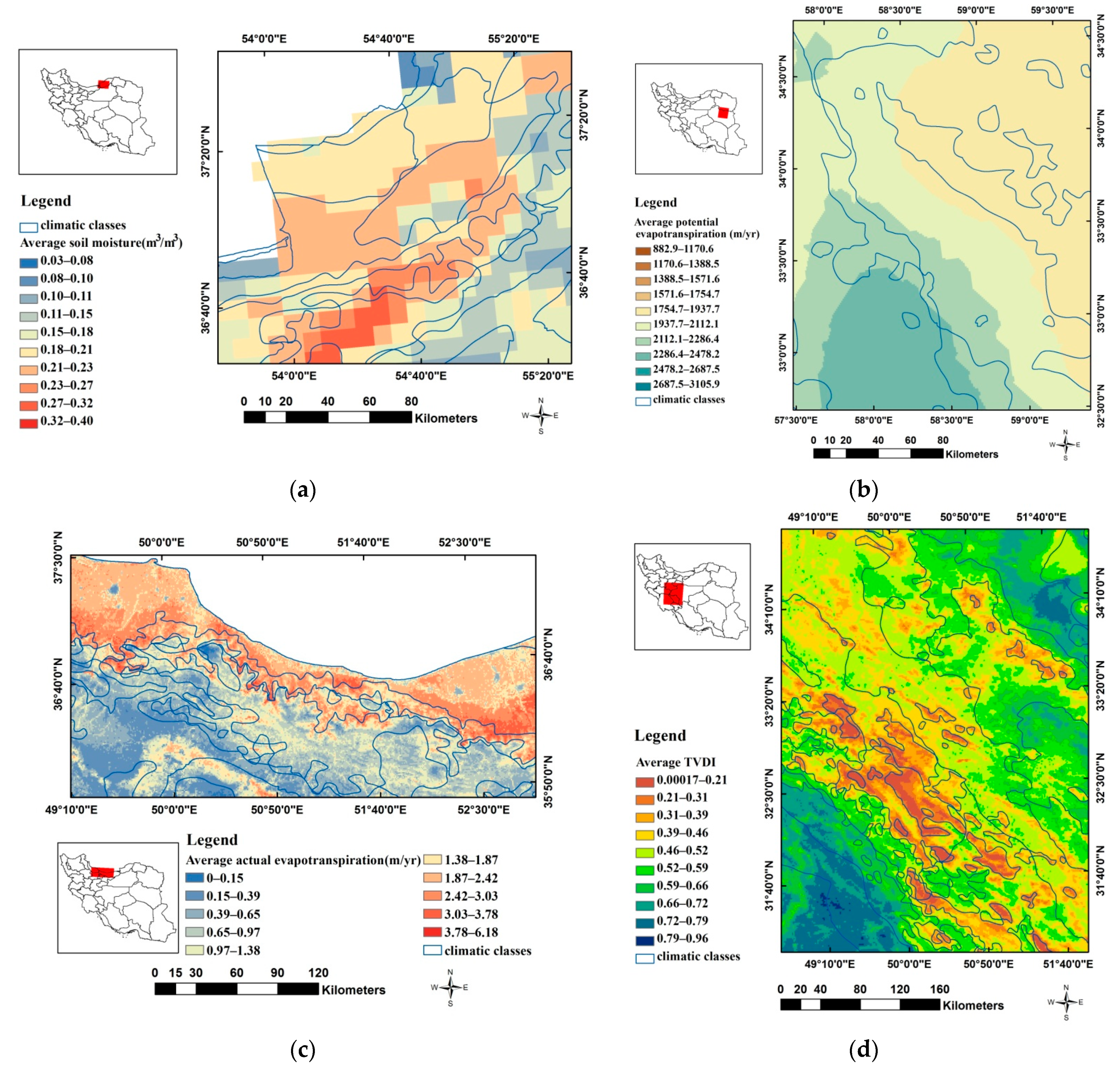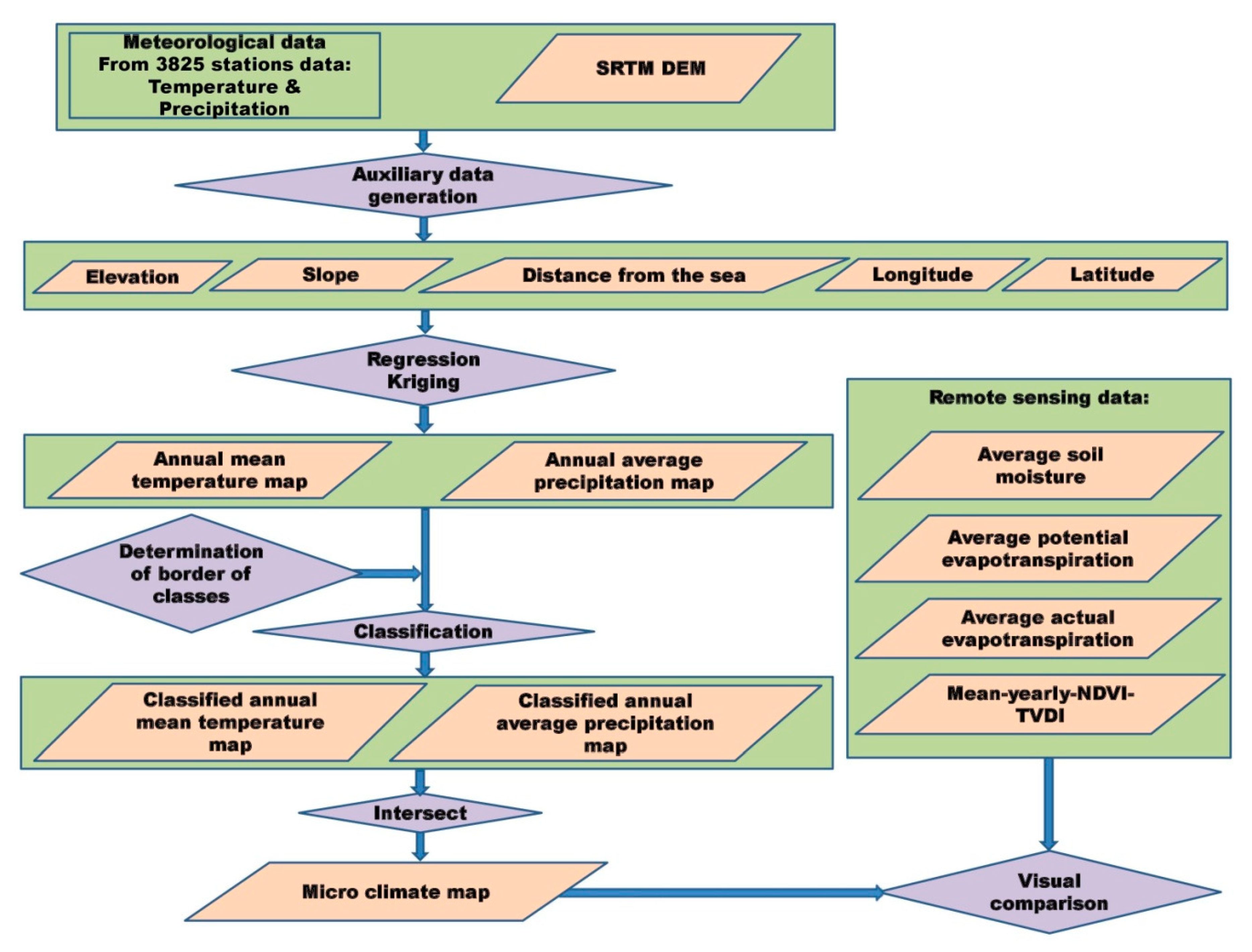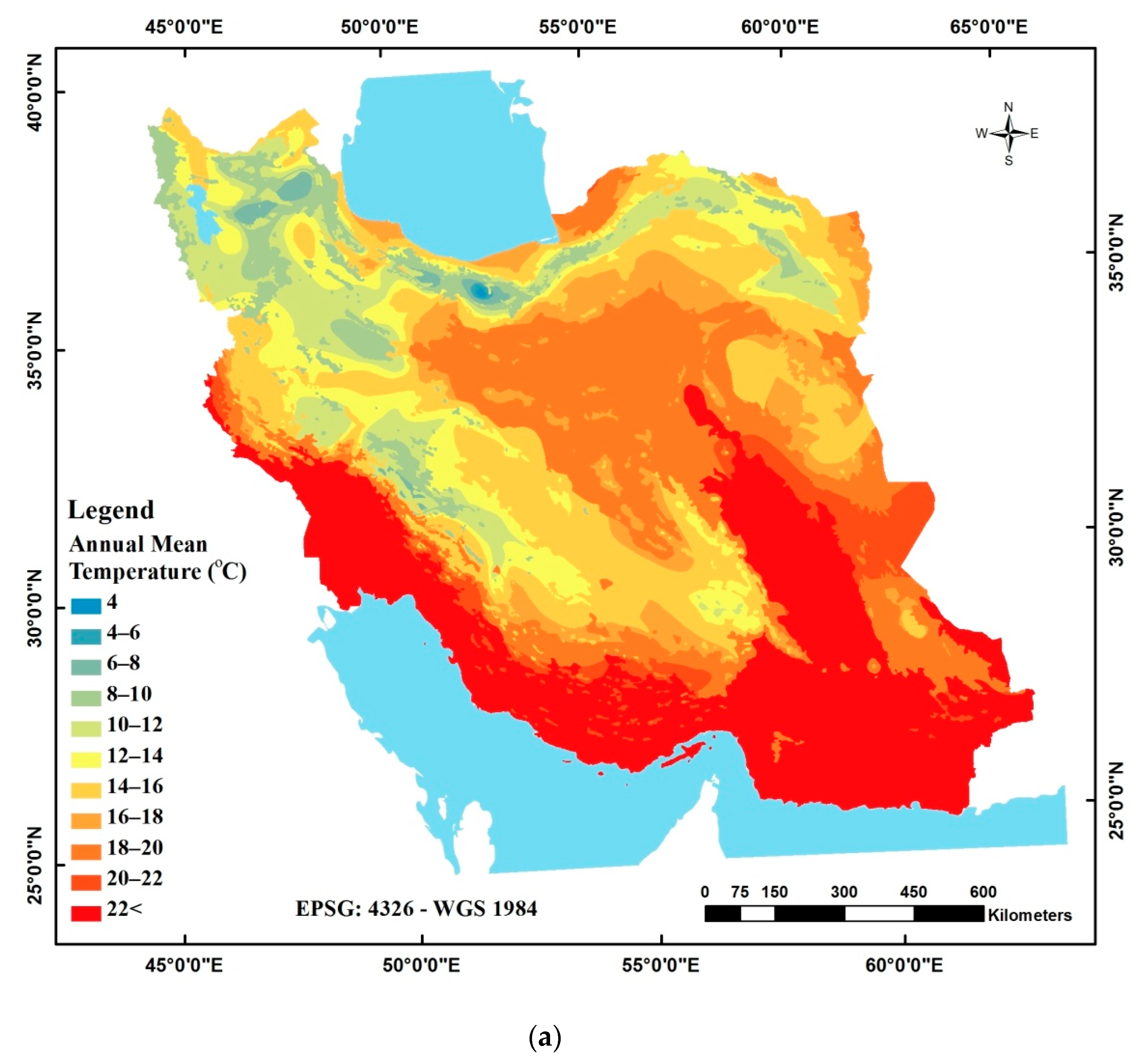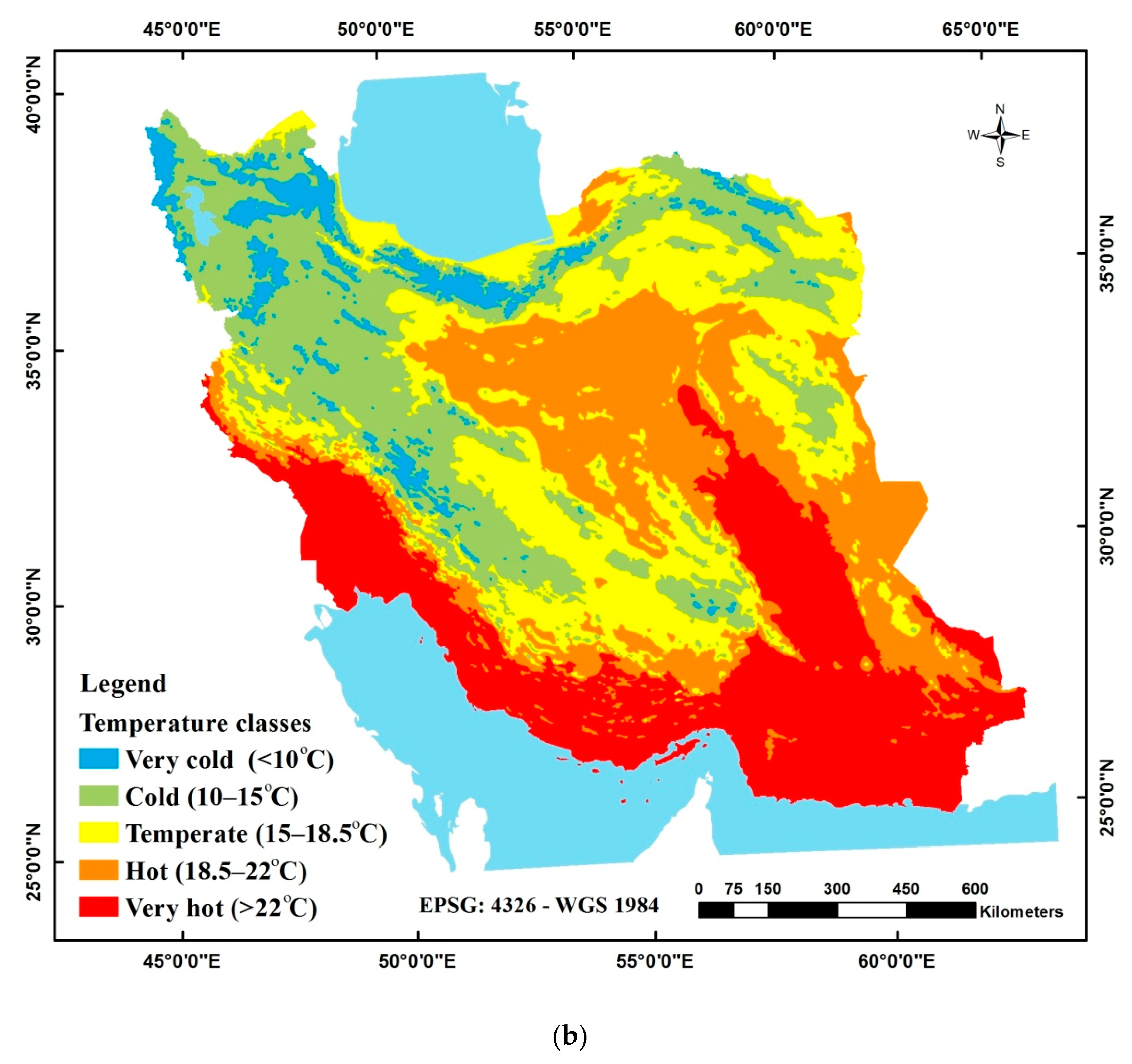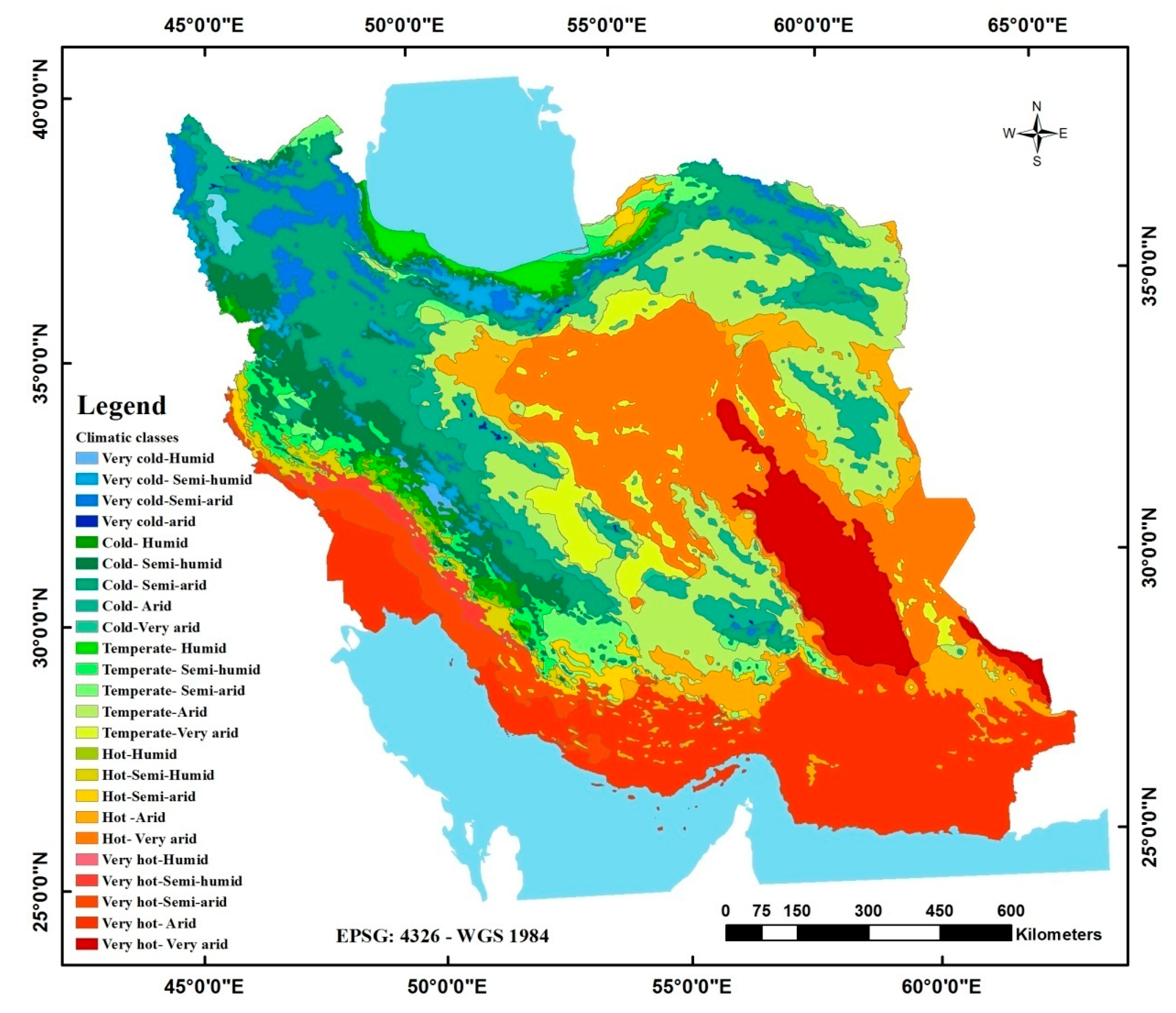1. Introduction
Nearly one-third of Iran’s territory is covered by mountains. The main characteristics of the precipitation regimes in Iran include low annual precipitation, severe annual and seasonal fluctuations in precipitation, short precipitation periods, and heavy rainstorms. Precipitation does not follow a specific pattern in Iran and varies with location. Differences depend on the direction and origin of the air masses affecting Iran, as well as the mountain aspect [
1]. The air temperature in Iran is considerably dependent on elevation, longitude, and latitude, the effect of elevation being considerably greater than that of the latitude. The climate in mountainous regions with a heterogeneous topography significantly changes due to the large elevation gradient over a short distance [
2]. Large-scale temperature variations in the mountains are mainly dependent on physical processes such as airflow; solar radiation; and interactions with topographic complexities including aspect, roughness, and shape of the terrain [
3]. Vegetation and geographical dispersion of humans locally affect the temperature [
4]. Different climates have been formed in Iran due to the wide latitude and vegetation variations and different terrains, such as deserts, dense forests, coastal regions, and high mountains.
Depending on the development level, between 20 and 80% of the changes in annual agricultural products are due to weather fluctuations, so between 1 and 5% of agricultural products are lost because of changes in the weather, in addition to severe losses from indirect negative effects, such as pests and diseases [
5].
Macroclimate data may be sufficient for plain physiographic units with small changes in land use, but the borders of climatic regions should be accurately delineated to explain the behaviors of animals and plants [
6].
Fine-resolution climate data is required for the correct prediction of plant species and their behavior in natural and anthropogenic environments. It has been found that spatial nonuniformity in climate variables makes temperature calculated from the direct local measurements to be twice as much as that calculated through global interpolation techniques [
7]. Spatial distribution models (SDMs) are increasingly growing around the world to respond to ecological questions ranging from climate changes to management challenges [
4]. However, SDM predictions mainly rely on the conditions of coarse resolution synoptic stations and fail to consider fine-resolution climate classes, because most climate variations in large-scale mountainous regions act as fine-resolution models. Accordingly, it is necessary to combine data collected from synoptic stations with auxiliary variables to achieve a finer spatial variability of climate variables. In a study of spatial variability of daily weather variables in the High Plains of the USA that was undertaken in a multivariable network, it is shown that, to explain more than 90% of the variation in the maximum temperatures between sites, a spacing of 60 km was sufficient on a year-round basis, while the minimum temperature required closer spacing (~30 km) to achieve this criterion. The spacing of precipitation gauges, for this criterion, would be less than 5 km [
8]. In another study, to eliminate the effect of uneven stations, using 736 meteorological station data (from 1961 to 2010) and the Inverse Weighted Distance (IDW) method, researchers detected the trends in climatic variables, including average precipitation, air temperature, solar radiation, and wind speed, for the whole of China and showed that there are three large-scale instrument replacements that increase the uncertainties of the trend analysis [
9].
Given the large distance between small-scale synoptic and climatological stations and the climate, class variations are smaller than these distances, and despite the need for accurate temperature and precipitation data, these stations cannot present microclimatic classes adequately. Moreover, establishing denser meteorological stations, even mobile stations or individual sensors, will be costly. To access more correct data, a change in scale towards a finer scale, known as interpolation, may be necessary [
10]. Multiple climate parameters used in traditional methods fail to represent the real climate classes. Many efforts have recently been made to provide a more realistic picture of the regional climate using geographical parameters. Additionally, the selection of auxiliary variables to increase the accuracy of climate zoning should result in a finer spatial resolution to take into account the mean, borders, and nonuniformity of the climatic variables [
4].
Geostatistical interpolation methods are often used for the interpolation of climatic variables [
11]. The kriging method models the spatial correlation of regional climatic variables (such as temperature and precipitation) using a semi-variogram. Changes in patterns of the spatial autocorrelation of the maximum temperatures of Iran were investigated in a study using 125 synoptic stations’ data (from 2010 to 1980) and kriging interpolation and showed areas with positive and negative spatial autocorrelations [
12]. Regression-kriging(RK) combines climatic variable observations with auxiliary variables such as height for the optimal estimations [
13]. The superiority of the regression-kriging method over conventional geostatistical methods in the interpolation of climatic variables has been shown in several studies [
14,
15,
16]. In the Jalisco state of Mexico, seven geostatistical interpolation methods were evaluated in predicting the monthly maximum temperature and monthly mean precipitation, and the results showed that the regression-kriging and thin-plate spline were the most efficient methods [
17]. In Extremadura, a region of Southwestern Spain, different geostatistical approaches to map climate variables were evaluated. In this study, the ordinary kriging (OK), simple kriging (SK), and universal kriging (universal kriging) methods were compared with three multivariate algorithms that take into account the altitude: collocated ordinary cokriging (OCK), simple kriging with varying local means (SKV), and regression-kriging (RK). The different techniques were applied to monthly and annual precipitation data measured at 136 meteorological stations in the region. Cross-validation showed that prediction performances vary among algorithms. SKV and RK provide the smallest MSE of estimates and, therefore, performed better. The SKV and RK maps are influenced by the DEM pattern and showed more details than the co-kriged maps [
18]. To determine the best interpolation method for the annual and seasonal precipitation of the Mashhad Plain in Iran, rainfall data from 63 stations (from 2004 to 2013) were collected. Five interpolation methods, namely Kriging, co-Kriging, Regression, regression-kriging, and Inverse Weighted Distance (IDW), were used. The root mean square error (RMSE) and mean bias error (
MBE) were considered to select the best interpolation method. The results revealed that the regression-kriging and three-variable regression (x, y, z) methods were the most accurate models to interpolate the annual precipitation over the study area [
19]. In another study, regression-kriging was used to map the winter chilling hours of mainland Spain. Temperature data from 72 meteorological stations (from 1975 to 2015) were used. The results showed that elevation and latitude are related to the chilling hours, enabling their use as auxiliary variables to better estimate unsampled locations and generate more accurate maps [
20].
Despite the vastness and nonuniformity of temperature and precipitation, climate studies in Iran have been conducted using limited meteorological stations. In a study, using some meteorological data such as temperature and precipitation, as well as solar radiation from 43 synoptic stations and multivariate statistics, Iran was divided into 6 homogenous climate zones and 12 climate subzones [
21]. In another research, underlying variables in the climate zoning of Iran were identified through factor analysis, decomposition of the main components, and monthly data collected from 41 synoptic stations [
22]. The most recent comprehensive study on climate zoning in Iran was conducted using meteorological data measured at 126 stations, through which, based on the UNESCO method and three indices of the humid regime, winter type, and summer type, a total of 28 climate zones were identified in Iran [
23]. Doostkamian and Mirmousavi [
24] divided Iran into four regions, according to the precipitation thresholds. The first zone is located along the Zagros Mountains and some parts of the southwest, which are influenced by the Mediterranean low-pressure and Sudanese systems. The second zone includes some regions of the southeast and the northern and the southwestern belts (except for the Caspian Sea coastline). Under the influence of a deep trough in the northeast of Europe and its extension into the Caspian Sea, this zone causes the advection of the Siberian air masses from northern latitudes in the Caspian Sea. The cooccurrence of these factors, and an increase in the maximum temperature difference between the cold polar air and the sea surface, significantly increases the precipitation rate in this region [
25]. The third zone includes the Caspian Sea coastline, where the negative vorticity of the sea at lower levels of the atmosphere, along with dominant, intense north–south currents, cause precipitation [
26]. The fourth zone is a low-precipitation area including the central, southeastern, and parts of the southern and southwestern areas of Iran.
According to the literature, domestic studies in Iran have mainly focused on a single or two climate parameters. Even in studies using different parameters, only limited regions in Iran have been investigated for certain land uses, and there has been no study on the identification of the basic climate situation, regardless of certain land uses. This study then aimed at the climate zoning of Iran, with a reasonable spatial resolution, by combining two important climate parameters (annual mean temperature and annual average precipitation, which were generated with all possible station data, carefully mapped, and classified using proper thresholds) and geographical auxiliary variables.
2. Materials and Methods
The methodology of the study is illustrated in
Figure 1.
2.1. Description of the Study Area
Iran, with an area of 1,648,195 km
2, is located in the arid belt of the Eastern Hemisphere, in West Asia, between the northern latitudes of 25–45° and the eastern longitudes of 44–63°. The country borders the Caspian Sea in the north and the Persian Gulf and Oman Sea in the south. Two ranges of high mountains, the Alborz in the north and the Zagros in the west, have a vital role in preventing the Mediterranean and the Caspian Sea winds near the central plateau of Iran. Based on atmospheric pressure, Iran is located in a low-pressure area, and accordingly, air currents form in the north and the northwest regions. The country has a variable climate. It is mild and quite wet on the coast of the Caspian Sea, continental and arid on the plateau, cold in the high mountains, and hot on the southern coast and in the southeastern region. The weather conditions of Iran are controlled by various factors. The relatively constant weather features in different regions of Iran have been formed because of different latitudes, reliefs, and proximity to large water bodies. The variable features are, however, influenced by the performances of atmospheric systems. Iran Meteorological Organization presented an agro-climatic classification for the country to organize and update the agricultural meteorological activities. In this classification, based on the major meteorological and agricultural characteristics of different areas, Iran was divided into six agro-climatic zones, including (1) the mountainous zone, (2) the Caspian humid zone, (3) the warm semi-humid zone, (4) the hot and humid coastal zone, (5) the semi-desert zone, and (6) the desert zone [
27]. This agro-climatic zoning was used as the basis for the initial division in this study (desert zone,
Figure 2).
2.2. Meteorological Data
Annual mean temperature and annual average precipitation data were calculated using data that were recorded from 2002 to 2016 at 185 synoptic stations and 3400 hydrometric stations from Iran Meteorological Organization (IRIMO) and 240 evaporation stations from the Ministry for Energy, which were used after being analyzed by the cumulative deviation test and quality control (
Figure 2). The annual mean temperature is calculated by averaging the whole period of daily temperature averages, and the annual average precipitation is calculated by averaging the annual summation of the daily precipitation data for each year.
2.3. Auxiliary Data
At first, using NASA’s Shuttle Radar Topography Mission (SRTM) instrument in a 90 m × 90 m raster network, the digital elevation model (DEM) was produced. Then, in ArcMap (Arc GIS 10.30 software, Redlands, CA, USA), slopes derived from DEM and two separate raster layers for longitude and latitude were generated with the same extent and resolution to be used. In addition, a raster of distance from water bodies was generated with the Euclidian Distance tool using the sea boundary shapefile in ArcMap. Then, the values of these rasters were extracted for all stations.
2.4. Remote Sensing Data
Four raster maps related to remotely sensed agricultural-related variables were prepared: (1) the average soil moisture (m
3/m
3), which is related to the moisture content of 5 cm of the soil surface, for which the data of 4 SAMP satellites (statistical period from 2015 to 2021) were used. Then, to calculate it, three-hour data were intercepted, and its resolution was 9 km [
28] (2). The average potential evapotranspiration (m/year), which is the annual evapotranspiration of the statistical period from 2009 to 2021 and was retrieved from the WaPORdatabase, and their average was calculated. Its resolution was 250 m (3).The average actual evapotranspiration (m/year), which is produced from the WaPORdatabase and is published by the FAO; ten-day data for the statistical period from 2009 to 2021 were downloaded, and the average statistical period was calculated. Its resolution was 250 m [
29] (4). The mean yearly TVDI (Temperature Vegetation Dryness Index) is one of the agricultural drought indexes and is calculated based on the NDVI and land surface temperature. Its resolution was1 km [
30]. Each of the components was downloaded from the MODIS satellite for a statistical period from 2000 to 2021; then, the index was calculated for each year, and finally, the total average for 22 years was calculated.
2.5. Descriptive Statistics
The minimum, maximum, average, median, standard deviation, skewness, kurtosis, and the coefficient of variation (CV) of the annual average precipitation and annual mean temperature data were determined. The normal frequency distribution of the studied variables was evaluated by the skewness and kurtosis significance tests. The CV was classified according to CV ≤ Md − Ps, Md − Ps < CV ≤ Md + Ps, and CV > Md + Ps, respectively, representing the low, moderate, and high classes where Md and Ps, respectively, represent the median and the pseudo sigma standard deviation, where the latter can be written as:
where
Q1 and
Q3 denote the first and third quartiles, respectively [
31].
2.6. Regression-Kriging
Regression-kriging is a hybrid geostatistical method that combines multiple linear regression between the target variable and secondary parameters with geostatistical methods, such as ordinary kriging or simple kriging, on the residuals of the regression. This method is done to optimize the prediction of the target variable in unsampled locations [
13] based on the assumption that the deterministic component of the target variable is accounted for by the regression model, while the model residuals represent the spatially varying but dependent component [
32].
SPSS software was used for statistical and regression analysis. To achieve greater comprehensiveness and to determine more significant variables in each agro-climatic zone, a stepwise regression method was used to develop multivariate linear regression. In this method, the linear correlation of variables was first determined, and after entering a new variable, variables that decreased their significance when adding other variables were excluded. The accuracy of the regression fitting was evaluated using the adjusted coefficient determination (R2a).
To reduce the temperature extrapolation error (as much as possible), a 10-km buffer was created around each agro-climatic zone, and the stations located in the buffer were also involved in the interpolation of the relevant zone. The equations obtained in each zone were applied to the whole zone and the surrounding buffer, and finally, by merging the zones and averaging the buffer zones, a particular thematic map was created for the whole country.
The independent variables were the digital elevation model (DEM) components, including the latitude (UTM), longitude (UTM), elevation (m), slope (%), and distance from the sea border (m), for all the stations. The dependent variables included the annual mean temperature and the annual average precipitation.
2.7. Geostatistics and Mapping
The climate zones were identified in various geographical environments by the simultaneous use of data processing techniques and tools employed in spatial data analyses and geographical studies.
To evaluate the spatial structure, variables lacking a normal frequency distribution were first normalized by logarithmic transformation. The spatial structure was then evaluated using the experimental semi-variogram. The values obtained from the experimental semi-variogram were fitted to spherical, exponential, linear, and nugget effect (
C0) semi-variogram models. The coefficient of determination (R
2) and the residual sum of squares (RSS) were used to evaluate the accuracy of the fitted model. Each semi-variogram consists of three components, namely the nugget effect, sill (
C0 +
C1), and the range. To determine the size and intensity of the spatial structure, the Cambardella Index (Ic) was used, which is the ratio of the nugget to the sill and indicates how the dataset is spatially arranged. Thus, Ic less than 25 show a strong spatial dependence and small erratic variance, while Ic between 25 and 75 show a moderate spatial dependence, and Ic greater than 75 demonstrate random spatial distribution [
33]. Additionally, the mean correlation distance (
MCD) was used to calculate the distance in which a high spatial dependence occurred in the variogram. In fact, the
MCD is an empirical index that provides some indication of the spatial structure [
34], and it was originally derived for soil properties. The greater the
MCD, the greater the spatial structure [
35]. The index can be written as:
where
C0 is the nugget,
C is the partial sill,
C0 +
C is the total sill, and
a is the range. The nugget effect represents random nonsystematic variations, and the spatial dependence decreases as its contribution to the total variations increases. The range is a distance at which variables have spatial similarity and dependence.
MCD is an empirical index that provides some indication of the spatial structure.
Regression-kriging was used for zoning the spatial distribution of the parameters. It is a hybrid method that combines two approaches; that is, regression is used to fit the explanatory variation, and ordinary kriging, with an expected value of 0, is used to fit the residuals, i.e., unexplained variations [
36]. The mean bias error (
MBE), the mean absolute error (
MAE), and the normalized root mean square error (
NRMSE) were used to evaluate the accuracy of the interpolations. These three indicators can be written, respectively, as
where
Oi is the observed value,
Pi is the predicted value,
is the mean of the observed values, and
n is the number of observations. The
MBE is used to estimate the average bias in the model, and the closer it is to 0, the lower the bias is. Its positive values represent overestimations, and its negative values indicate underestimations. The
MAE is one of the best overall measures for evaluating the agreement between observed and predicted data [
37], and when it shifts to zero, the applied method simulates this fact well [
38]. Moreover, a simulation is considered excellent if its
NRMSE is less than 10%, good if it is greater than 10% and less than 20%, fair if it is greater than 20% and less than 30%, and poor if it is greater than 30% [
39]. Based on the best interpolation method for the annual average precipitation and the annual mean temperature, the spatial distribution of the different parameters was generated for the whole country. The spatial patterns of data and fitting of the semi-variogram models were analyzed using geostatistical software GS+ version 5.1 for Windows (Gamma design, Inc., 2000, Cambridge, MA, USA). Then, Arc GIS 10.3 was employed for the interpolation methods and preparation of the annual mean temperature and annual average precipitation maps.
2.8. Classification of Produced Maps and Preparation of Climatic Maps
A great challenge facing climate classification is to delineate the borders of temperature and precipitation classes because of the continuous nature of both parameters. Additionally, every parameter should be classified in such a way that the classes generated in combination with other classes lead to significant classes. The use of mathematical and statistical indices such as quartiles in determining the classes of each parameter may lead to insignificant climate classes, which are uninterpretable. Therefore, the borders of the precipitation and temperature classes were determined and delineated in meetings with IRIMO and the Iran Ministry of Agriculture experts. Then, the classified temperature and precipitation were sent to the selected synoptic stations to receive the experts’ opinions and assessments regarding the accuracy and consistency between the map outputs and the local data, as well as some ecological items such as vegetation patterns using Google Earth or some available maps.
In the next step, using intersect tool in ArcMap, the two final classified maps (annual mean temperature and annual average precipitation) were overlayed to obtain a climatic map. To check the accuracy of the map, experts’ opinions were used.
2.9. Significance and Application of the Generated Climatic Map
Since a detailed quantitative comparison is beyond the objective of this study, just four raster maps related to remotely sensed agricultural-related variables, including the average soil moisture (m3/m3), average potential evapotranspiration (m/year), average actual evapotranspiration (m/year), and mean yearly TVDI (Temperature Vegetation Dryness Index), were visually compared with the generated climatic map to have a look at the qualitative significance of the generated map for future forthcoming studies.
4. Discussion
The large nonuniformity of the annual mean temperature is expected due to the vastness of Iran, large elevation variations, and proximity to the Persian Gulf and Oman Sea in the south and the Caspian Sea in the north.
The annual average precipitation is a function of latitude and elevation. The maximum annual precipitation is mainly observed near the Caspian Sea in the north of Iran. Considering Equation (7), it can be concluded that relief plays a key role in the arrangement of different precipitation classes in Iran. The annual temperature increases by 2.6 °C from west to east per 10,000 km, whereas the temperature increases by 7.8 °C from north to south. However, increases in elevation have different impacts on precipitation. Precipitation usually increases as the elevation increases up to a certain amount, decreasing afterward. Furthermore, a change in the latitude of different regions may cause a change in the precipitation rate due to permanent rotation cycles of the atmosphere [
40]. According to the calculated equation, precipitation increases with the increasing latitude, which is relatively connected to Iran’s topography. The precipitation system influencing Iran from the Mediterranean Sea causes the maximum precipitation in the Zagros Mountains, which gradually decreases with the increasing longitude towards the center and east of Iran. Precipitation also increases with the increasing elevation, except for the Caspian Sea coastline, with a negative elevation below the sea level, the zone that is rainier than other regions due to specific climatic and topographic conditions. Lower precipitation rates are usually recorded at the stations located at positive elevations above the sea level in other regions. The combination of these two factors leads to a negative regression coefficient with increasing elevation.
According to the semi-variogram model fitted to the studied variables, the annual mean temperature showed more spatial dependency than the annual average precipitation. It may be assumed that the decrease in spatial dependency in the annual average precipitation is due to the nonuniform topography, and most parts of the western and northern areas are more affected by the Mediterranean humid air masses than the central, eastern, and southern areas of Iran. Based on Cambardella classification [
33] and
MCD, the annual mean temperature showed a higher spatial dependency at larger distances.
The results of the stepwise multivariate regression fitting showed that the annual mean temperature follows the geographical coordinates and height in six agro-climatic zones. In fact, the temperature decreases with the increasing elevation and latitude. The changes in the atmospheric parameters, including temperature and precipitation, are consistent with the variations in the spatial and topographical characteristics. The lapse rate, the rate at which the temperature changes with the height in the atmosphere, is an indicator of the direct impact of elevation on the temperature. Due to the effect on the angle of solar radiation, the latitude causes a change in the temperatures of different regions. The air temperature decreases from east to west and from south to north. Latitude plays a much more significant role than longitude in the spatial variability of the temperature across Iran.
The generated map for the annual mean temperature is highly consistent with a previous study by Aliabadi and Roudbari [
12], in which the combination of the spatial statistics methods and autocorrelation indices demonstrated a negative spatial autocorrelation of the maximum temperature (low-value temperature clusters) on the Caspian Sea coastline and the west, northwest, and southeast of Iran. In contrast, some regions in the center and southwest of Iran showed a positive spatial autocorrelation (high-value temperature clusters) [
12]. Accordingly, most mountainous regions and highlands in Iran are dominated by lower temperature values. However, the southeast and southwest of Iran show the maximum temperature due to high humidity, and the Dasht-e Lut and Dasht-e Kavir with poor cloudiness.
The resulting zoning for precipitation is very similar to that reported by Doostkamian and Mirmousavi [
24], who divided Iran into four regions according to precipitation thresholds.
Comparisons of the existing maps from previous studies such as Heidari and Alijani [
21] and Ghaffari and Ghasemi [
23] in Iran showed that the newly generated map has acceptable and more realistic classes thatare due to: (1) the use of the maximum data (3825 stations) to increase the spatial density of the stations and, thus, increase the spatial resolution, (2) the preparation of two temperature and precipitation rasters using the regression-kriging method, which provided a good basis for creating a microclimate map, and (3) Instead of using global thresholds, an attempt was made to use the opinions of experts to find the appropriate thresholds for classification, which resulted in the creation of more climatic classes. In fact, the 24 climate classes showed that using auxiliary variables and careful classification of the basic maps were very effective in detecting different climatic classes and, therefore, understating the climate diversity in Iran. Hot to very hot and arid to very arid climate classes were identified as the largest climatic classes of Iran, which cover Iran’s southeastern and southern desert regions. As a result, the generated map can be very beneficial for many environmental and agricultural studies, such as land evaluation studies, which consider soil and landscape characteristics and climatic parameters to suggest the most proper plant for each land to tackle the water shortage, preserve soil, and achieve sustainable agriculture.
The visual comparison of four raster maps related to remotely sensed agricultural-related variables, including average soil moisture (m3/m3), average potential evapotranspiration(m/year), average actual evapotranspiration (m/year), and meanyearly TVDI (Temperature Vegetation Dryness Index) with the generated climatic map, showed that there was a sort of agreement between these variables and the climatic generated map; thus, such high-resolution climatic maps can be a very good starting point to generate microclimatic maps, as well as it is suggested to use climatic maps to better classify, assess, and interpret remote sensing-based agricultural applications to be planned out in the close future.
6. Conclusions
In this study, using the long-term average precipitation and temperature measurements for the 2002–2016 period from 3825 meteorological stations, geographical auxiliary variables, regression-kriging, knowledge of Iran Meteorological Organization and Iran Ministry of Agriculture experts, all attempts have been made to generate new and precise maps of the temperature and precipitation for the country. Based on the CV, the annual average precipitation and the mean annual temperature, respectively, showed moderate and large variations. The generated annual mean temperature map indicated a decline in temperature from east to west and northwest in high-altitude areas, while the Caspian Sea coastline and the Zagros Mountains experienced the highestprecipitation values. By applying five delineation thresholds on the maps and intersecting the classified maps, Iran was divided into 24 climates (precipitation–temperature) zones. According to the evaluation statistics and matching generated maps with expert knowledge and some ecological items, the delineation and diversification of the climatic classes were really acceptable. According to the generated climatic map, hot to very hot and arid to very arid climate classes occupy the largest part of Iran, which are located in the southeastern and southern desert regions. The climatic diversity indicated that the regression-kriging method was useful for mapping climate zones, and the resulting map can be used for decoding natural selections andthe management of resources, especially water consumption, sustainable agricultural planning, determining the cultivation pattern, and optimizing agricultural and horticultural calendars. Furthermore, the simple visual comparison between the climatic zones from the generated climatic map and four remotely sensed agricultural variables clearly shows the usefulness of these carefully produced climatic maps for classifying, evaluating, and interpreting these and other remotely sensed agricultural-related variables and producing microclimatic maps using these types of remotely sensed variables.
